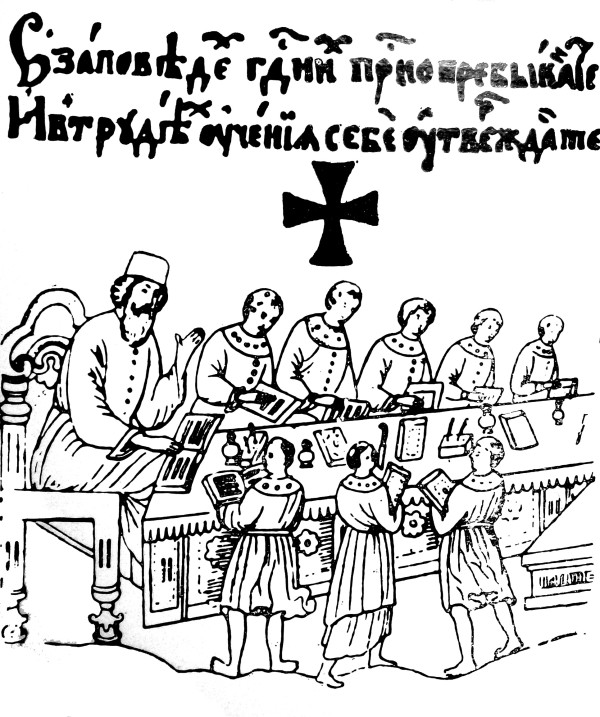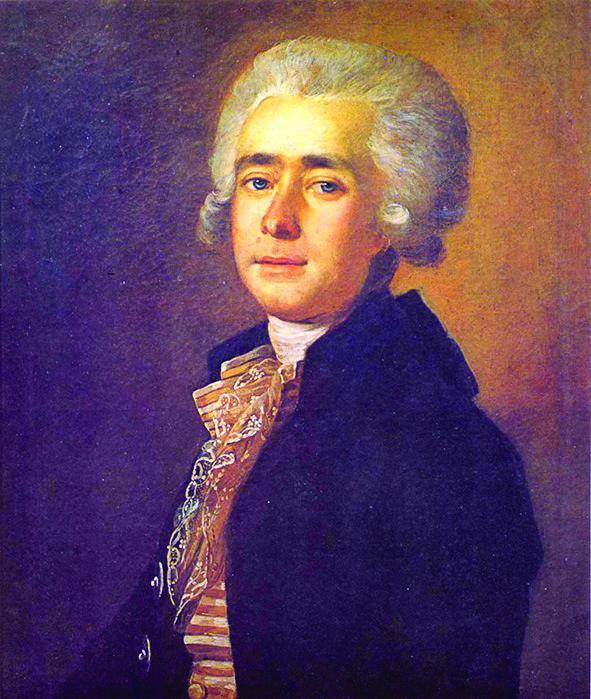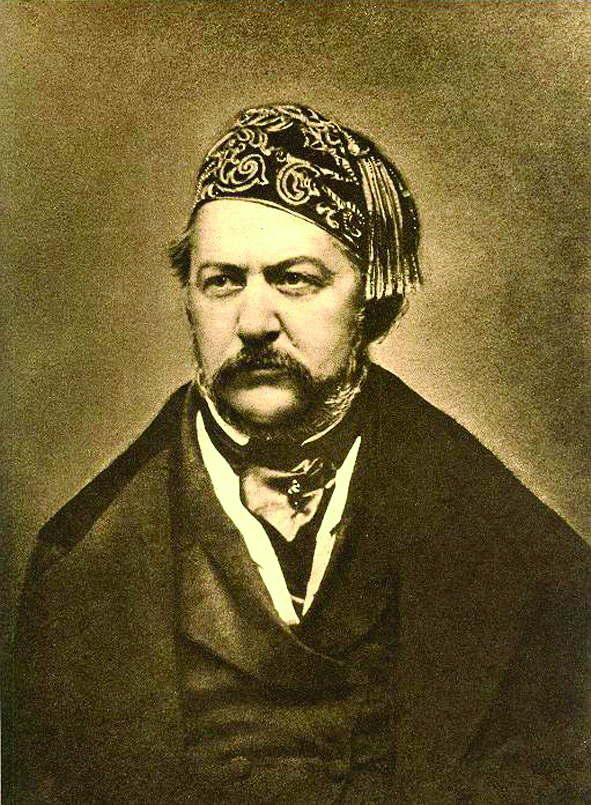The Birth and Evolution of the Choral Art in Russia
From the spread of Christianity in the ancient Russian state at the end of the 10th century until the collapse of the Russian Empire at the beginning of the 20th century
Claudia Nikol’skaya-Beregovskaya
The choral culture of ancient Russia
History, regarding the evolution of Russian choir singing, has not left any sources recounting the musical culture of the Slavs up to the time when Christianity was adopted in Russia. However, a folkloric song, transmitted from generation to generation in oral form, provides evidence that ancient Russian singing, as an art form, had reached a high level.
Slavic singing was usually done without musical instruments, but sometimes it was accompanied by the playing of wind instruments, for instance Slavic flute, zhaleyka, bagpipe and toot (a type of horn); percussion instruments such as timbrel and drum; or string instruments such as gusli.
During the long period following the adoption of Christianity, musical art was grounded in “pagan antiquity” and pagan ceremonialism, taking a prominent place in ancient Russian life from the prince’s palace to the rural huts.
In 988, after the Christianization of Kievan Rus’, the Russian Church adopted the Byzantine Greek creed in the form preserved by the Greeks themselves. So what did the newly Christianized Russia gain in the way of church singing?
The first gain was a body of readily available, completely fixed textual material translated into Slavic languages for the annual cycle of church services – a task accomplished up to the end of the 10th century by Balkan Slavs. Secondly, there were readily available chants in the Eight Modes (intonation structures known as hlasy) from the orthodox East, written in the stolp notation of liturgical music books, and also types and styles of solo and choral church singing taking place in the East. Here, we also need to put aside Western musical/vocal trends and consider the strictly vocal, melodic nature of singing along with the patristic viewpoint regarding church singing tasks.

Additionally, songs in stolp notation (namely, Znamena – meaning “signs”, or Kryuki – meaning “hooks”) from the Greek church came to Russia and were later reworked in Russian songs. Signs – Kryuki or Znamena – did not indicate the required pitch or duration of a tone but merely denoted the rise or fall of the voice, the emphasis of distinctive words or phrases, and the vocalization patterns of a liturgical text.
In the process of developing the art of singing, Russian people formed a distinctive singing style, which defined the basic features of the national vocal and choral schools. Singing, above all, was characterized by a respectful attitude towards words. It is quite well known that speech and musical aspects flow together in Russian folk songs. People do not recognize song without words, and melody lines can be repeated as many times as required by a song.
The melodies of church singing and those of folk songs served as a musical interpretation of the text. A singer was required to know hundreds of specific melodic phrases called Popevky, which symbolically expressed a particular image of the liturgical text. However, the conventions of hook marks also allowed certain exceptions to the melodies and the possibility for creative modifications. Greek records served as a kind of canvas on which the Russian singers “embroidered” a melodic pattern as suited their artistic taste, and if we compare the Byzantine chants with the Russian ones, a certain independence can be seen in the latter.
The development of feudal relations led to the disintegration of Kievan Rus’, thus forming large and small principalities within its territory. In the capital cities of the principalities, each church cathedral had its own choir and a corresponding school of singing. According to Nikolai Uspensky, one of the best connoisseurs of Russian church music: “Thanks to the emergence of more and more choral music from the choral singing culture centers … it was possible to clear away the elements of Byzantine culture inherited by Kievan Rus’ and develop distinctly Russian characteristics. Creation of the distinctively Russian Eight Modes was one of the important aspects of this process.” [N. Uspensky, “Ancient Russian singing art”, M., 1971, p. 69]
In the first half of the 16th century, there was the integration of Russia and the creation of the monarchist-centralized state, with the capital city being in Moscow. Merging of principalities led to the creation of a common Russian national culture in the fields of literature, architecture, and singing, which developed out of the mutually enriching interaction between singing schools in Novgorod, Vladimir, and other Russian cities.
In 1551, the Moscow Cathedral’s ruling power required the clergy to create home-based public schools to teach reading, writing, book writing, and church singing. Moreover, King Ivan (the Terrible) established, in the Alexander settlement, a sort of high school dedicated to the art of singing. He began to invite the best singing artists there, and they founded the Moscow singing school. Among them are some famous names: the Rogov brothers and Theodore the Christian.
In Novgorod in the middle of the 16th century, there was a singing school, of which Marcellus A-Beardless (who, according to a legend, set the Psalter to music) was a prominent representative. Novgorod masters also brought the art of varying the Popevky of Znamenny chant to a high degree of artistic excellence.

The birth of polyphony
The ancient singing art researcher Viktor Belyaev suggests that polyphonic singing in Russia may have existed before the 12th and 13th centuries in the form of episodic heterophony.
In the second half of the 16th century in Novgorod and Pskov, during particularly solemn days of morning and evening services, the “Great Doxology” hymn, a Psalmody incorporating support voices, was performed. While in Novgorod and Pskov, Ivan the Terrible brought attention to this feature of the music, and at the Moscow Cathedral in 1551, he gave an order for polyphonic singing to enter Moscow.
There were several varieties of ancient Russian church polyphony. The best-known ones are line singing and the very solemn demesvenny polyphony, containing episodes of dissonant sound interspersed with moments of harmony and euphony.
Thanks to the creativity of the Russian masters, demesvenny polyphonic singing rose to significant artistic heights.
Part songs
Having existed for a relatively short time without firmly establishing itself, church line singing was supplanted by part songs, which came to Russia from Poland and Ukraine.
Fraternal organizations in the southwest opened up schools in Orthodox monasteries, and the teaching of choral church singing in these monasteries was compulsory. Choral repertoires consisted of Kiev monophonic melodies, which had choral harmony arrangements based on the Western model. Southern Russian Slavs mastered this practice, and upon moving to the Moscow state, they brought with them a new art of choral singing never before heard in Russia.
Borrowing a number of elements from line singing, polyphonic singing in Russia lost the severity of its harmonic counterpoint (“note against note”). It also became associated with national characteristics – beginning with unison singing, followed by separation of voices and live recitation of a bass line that gives amplitude to the vocalization. Adopting Western European harmony as their foundation, Russian masters, in the second half of the 17th century, kept elements of their linear-based thinking and preferred Russian polyphonic writing methods that employed the iteration and the supporting voice.
Patriarch Nikon (1605-1681) contributed greatly to the spread of part songs. He loved the brilliance of worship services, which were unthinkable to him without appropriate musical accompaniment, so he introduced part songs to the choir of the Moscow Patriarch and to the monasteries, as well.
The Saint Petersburg court cappella
In Russia, the most revered top-level choirs and educational institutions were the Court Cappella in St. Petersburg and the Synodal Choir, which was part of the Synodal School which taught church singing in Moscow.
The history of the appearance of these choirs goes back to the reign of Ivan III. During that period, the Assumption Cathedral in Moscow (1479) was founded, and a choir made up of the sovereign’s singing clerks was created there. In 1589, a Russian patriarchate was established, in which the choir of the Patriarchal clerks was created. This choir was afterwards renamed the Moscow Synodal Choir, and the choir of the sovereign’s clerks was transferred to St. Petersburg by Peter I in 1703 and transformed into the Court Cappella. Both choirs gained great popularity, especially among foreigners, and they astonished audiences with the beauty of both their treble and bass sections. The choirs enjoyed many privileges and received a state allowance.
The ambition of the first professional choirs was to participate in the Court Cappella services and other entertainment for the king of the festivities, where the choir performed so-called “secular” music, namely, Russian folk songs.
In the 1730s, Italian vocal music began to penetrate into Russia. Musicians, invited from Italy, first performed small interludes, and from 1737 onward, they performed operas, in which Russian choirs would also participate. Due to their large number and great sound, these choir operas enjoyed great success with audiences.

The accessibility of training in church singing to people of different social classes made it possible to select singers for professional choirs. Not surprisingly, the Court Cappella had singers who were richly, naturally gifted. Vocal and musical training was also taken very seriously by the Cappella. Singers acquired such strong vocal skills that they could successfully handle solo parts in the Italian operas if necessary.
Italian masters were not only staging opera performances but also teaching singing to gifted Cappella singers, and F. Araya (1709 – ca. 1770), B. Galuppi (1706-1785), D. Sarti (1729-1802), and V. Manfredini (1737-1799) all served in the role of Kapellmeister.

The Court Cappella achieved especially good results under the direction of prominent composer Dmitry Bortniansky (1751-1825). According to memoirs of his contemporaries, the Cappella’s sound at the time evoked softness and evenness with extraordinary purity of tune. But the most striking feature of the choir sound was the organ, which subsequently became the hallmark of this team.
The Court Cappella garnered pan-European fame from the 18th century onward. Foreigners admitted that they had never heard anything like this in the way of skill, wealth, and level of artistry outside of Russia. After a visit to St. Petersburg in 1847, Hector Berlioz wrote: “This is the best choir that exists, or perhaps ever has existed, among similar institutions in Europe”.
The development of choral performance in Russia in the 19th century
From the end of the 18th century in Russia, growing educational trends led to a sharp struggle against foreign domination. In the field of choral performance, such trends were manifested as an attempt to restore the national choral tradition, and as a reflection of this attempt, private, student, amateur, peasant, and even worker choirs began to spread across the country in the mid-19th century.
From the end of the 19th century onward, there existed famous choirs supported by noble patrons, for example, Count Sheremetev’s choir, headed by prominent choir conductors Stepan Degtyarev (1766-1813) and Gabriel Lomakin (1811-1885), and the Cappella of Prince Golitsyn.
The Russian Empire’s 1812 war victory over Napoleon led to a revival of the nation, and the establishment of a national school of composition actively contributed to the development of choir singing.

The founder of Russian classical music Mikhail Glinka (1804-1857) relied on folk art and church singing in his work. Moreover, Glinka became convinced that the harmonization of Russian church chants and original compositions for the church should not be based on Western rules of counterpoint but on ancient church modes, and a similar aesthetic position was held by many other 19th century Russian composers such as Mussorgsky, Tchaikovsky, and Rachmaninoff.
Russian school choir singing experience acted as a prerequisite for the development of theoretical thought in the field of vocal training. This fact is evidenced, in particular, by the emergence of Glinka’s “Exercises” and Varlamov’s “Complete Singing School”, where the authors developed a type of vocal training based on distinctive Russian folk song melodies.
In 1862, the head of the Count Sheremetev’s choir Gabriel Lomakin, along with the composer Mily Balakirev (1837-1910), opened the Free School of Music in St. Petersburg for people to prepare as teachers of singing. The second half of the 19th century was marked by a common desire among Russian intellectuals to give their knowledge, in all fields of science and art, to the noble cause of educating the people. The Free School of Music Choir, along with free choral singing classes in Moscow and St. Petersburg, brought various segments of the population in contact with representatives of academic choral singing. By the end of the 19th century choirs of very high level appeared among amateur choir teams, including the Arkhangelsky Choir, Chorus Prechistensky workers’ courses in Moscow, Rukavishnikov Choir in Nizhny Novgorod, Kastorsky Choir in Penza, choirs of military cantonments, and port worker singers in Arkhangelsk.
At this time, trends in the art of folk singing were also actively developing. An important role in the history of Russian folk choir development was played by a magnificent choir of peasants led by Ivan Molchanov (1808-1881). A gifted teacher, Molchanov came to incorporate child singers into the choir and also taught them music theory and musical notation. At the domestic level, the “Choir College” was formed, fostering a veritable galaxy of Russian folk singers and choir masters. Also notable among 19th-century folk choirs are those of Dmitry Agrenev-Slavyansky (1836-1908), Peter Yarkov (1875-1945), and Mitrofan Pyatnitsky (1864-1927).

The Moscow Synodal School of Church Music
The Moscow Synodal School of Church Music and its Synodal Choir became the largest center for church music research and for training highly qualified teachers of singing and chanters. Its organizers and leaders, from renowned spiritual and cultural centers, were prominent figures in Russian culture such as Stepan Smolensky (1848-1909), Vasily Orlov (1856-1907), and Alexander Kastalskiy (1856-1926), who reformed church education and created a new, totally unique form of vocal organization with the Synodal choir.

Vasily Orlov took on the task of drawing public attention to the experience of reviving ancient Russian choral music with new compositional tools and techniques, and the best musical forces in Russia were engaged for this purpose, including Peter Turchaninov, Peter Tchaikovsky, Victor Kalinnikov, Alexander Gretchaninov and Sergei Rachmaninoff. For a long time, the polyphony in Russian church singing had been polychoral, with double and even triple division of voices, sometimes as many as twenty-four or more. Stepan Smolensky wrote to his friend Nicholas Findeyzen: “Can you believe I found a liturgy for no fewer than twelve choirs (48 voices) and two concerts for it from Yaroslavl from the 17th century or early 18th century? What kind of Russians were these people ?!”

These efforts at polychoral singing may be attributed to the need for aesthetic beauty in the timbre of the choral sound. Polychoral compositions are distinguished by multi-layered textures, thus allowing for a different rhythm in each vocal part and an interplay of timbral colors.
Observing the artistic skills of church choral singers, Smolensky and Orlov saw their transformation in perspective from a choir into a kind of “choral orchestra.” To achieve diversity in timbral colors, Orlov departed from the usual construction of the choir, dividing it into “heavy” and “light” sections, with each section then divided into so-called “stands” (as in an orchestra). Each stand united four to five singers with voices similar in tone, thus enabling the conductor to use the right color for a particular section of music and enriching the sound palette of the chorus as a whole. Achieving a diversity of color shades, Orlov created amazing sonic effects, which astounded his audiences.

After Orlov’s death, Nikolai Danilin (1878-1945) succeeded him in the post of chief conductor, and the Synodal Choir surpassed even its own former glory. Under the direction of Danilin, the Synodal Choir first performed Sergei Rachmaninoff’s All-Night Vigil. During one of the choir tours in Europe, the German press wrote: “The character of this wonderful oriental singing is authentically Russian – a great mix of ancient semi-barbaric elements with a mature culture … Magnificent vocal material by itself could not produce these one-of-a-kind effects if not for centuries-old traditions, the perfect training system of the Synodal School, and a leader like Nikolai Danilin”. [N. M. Danilin: Letters, Memories, Documents. Moscow, 1987. p. 40-43]
From 1917 onward …
After the revolution of 1917, Russia became a new state whose way of life changed the Russians’ spiritual life in many ways.
Choral art, as the most widespread of the arts, was particularly sensitive to the demands of the time. Composers from those years – Alexander Davydenko, Reinhold Glière, Isaac Dunaevskii and others – began to pay much attention to the mass song, with its more civic-minded subject matter.
Many of the choirs that existed in old Russia disbanded. The Synodal choir also ceased to exist. There was a need for choirs that could perform their repertoire at the same high professional level but with different subjects. In 1936, for example, the State Choir of the USSR was organized, led in 1937 by Nikolai Danilin. Looking back on this outstanding Russian choral conductor, one of his disciples named Moses Nahimovskiy, the master of amateur choral performances, wrote: “I do not know how Nikolai Danilin handled the October Revolution, but he was unable to imagine himself outside of Russia and Russian choral art and could not stay away, even though much of what was happening was at odds with his views …” [N. M. Danilin: Letters, Memories, Documents. Moscow, 1987. S. 174]
Edited by Steve Lansford, USA and Irene Auerbach, UK